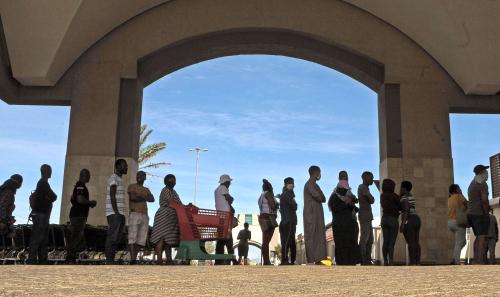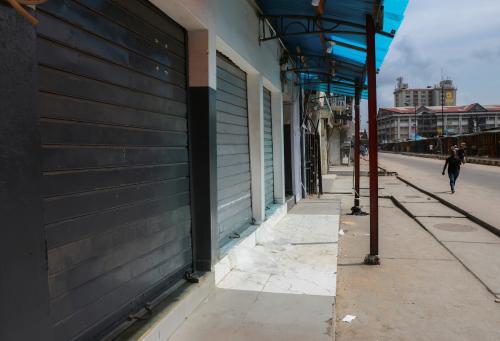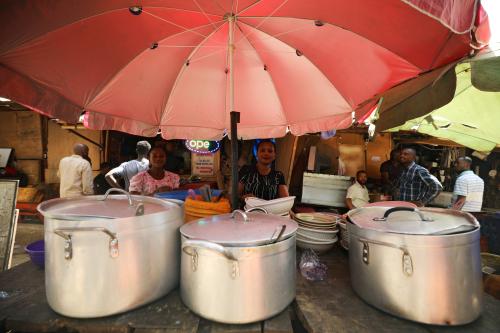Emerging markets and developing countries have about $11 trillion in external debt and about $3.9 trillion in debt service due in 2020. Of this, about $3.5 trillion is for principal repayments. Around $1 trillion is debt service due on medium- and long-term (MLT) debt, while the remainder is short-term debt, much of which is normal trade finance.
For the poorest countries (all those eligible for support from the International Development Association or IDA), 2020 MLT debt service is about $36 billion, divided in roughly equal proportions between multilateral, bilateral (mostly non-Paris Club), and commercial creditors.
All developing country regions are potentially seriously affected: Latin America has the highest debt service/exports ratio, Africa has the least diversified export mix, East Asia has the largest absolute amount of debt service.
In normal circumstances, the principal amounts would simply be refinanced in global capital markets or offset by new disbursements from existing lenders. But circumstances are not normal. Credit markets have tightened, spreads have risen, and many countries are faced with very large reductions in foreign exchange revenues. In the face of huge global economic uncertainty, it is hard to predict which countries and regions will be most vulnerable, and not all the vulnerability has been caused by the pandemic. Already, Venezuela, Argentina, and Lebanon have defaulted and face lengthy and damaging legal proceedings with each creditor trying to negotiate individually, resulting in dead-weight losses for everyone until the situation is sorted out.
One indication that the problem is widespread is that already 90 countries have approached the IMF to access emergency financing instruments. It seems clear that this is not just a low-income or an African country problem.
There are several calls for debt standstills (here, here and here) to ease the burden on developing countries. Debt threatens to create a global development emergency in much the same way as the pandemic is creating a global health emergency. Both could result in social unrest and instability. Something will have to be done, so it is useful to recap the lessons from previous debt crises.
Timeliness and urgency are important. Many developing countries simply will not have the foreign exchange to service their debt this year, notably those who are heavily indebted, are commodity dependent (two-thirds of all developing countries according to UNCTAD), have relied on large tourism receipts, or on remittances. A good example of the value of buying time is the negotiated rollover of private bank credits to Korea in 1997-98, aided by regulators who agreed not to call the measures a technical default.
In the current context, timeliness means that case-by-case solutions may not be feasible. Like COVID-19, there is a need to flatten the curve of debt reschedulings so that the peak falls within the capacity of the system to handle them. Hence the calls for the G-20, the IMF/World Bank, the U.N. or others to develop a simple debt standstill framework that can buy time for proper sustainability analyses to be done on a country-by-country basis.
All creditors must participate. In the early days of the mid-1980s debt crisis, the Baker plan sought voluntary extensions of new credits by banks to highly indebted countries, to permit them to grow out of their crisis. In the event, banks provided one-third less money than anticipated and the plan largely failed to meet its objectives because a group of midsized banks had incentives to free ride and exit. Commercial banks similarly exited ruble bond markets when a large IMF package to help Russia deal with its 1998 debt crisis did not address private debt and capital flight. The IMF’s legal framework, however, precludes it from providing financial support without its program directly addressing debt sustainability, so the IMF is able now to encourage private creditors to accept haircuts as a precondition of a program—a design feature that was used to good effect in the case of Ukraine in 2015.
Currently, there are two groups of potential free-rider creditors who are quantitatively important but who do not participate in any formal debt restructuring processes like the Paris or London clubs: private holders of bonds without collective action clauses, and official lenders from China and other non-OECD countries. However, for both political and financial reasons, it would be hard to have an effective response today without including these two groups of creditors.
Market-based solutions can work but require a degree of coordination and comprehensiveness. In the 1980s debt crisis, the Brady Plan gave banks an option to exit by taking a haircut in exchange for credit enhancements on loans restructured into bonds. Since then, many developing countries have tapped bond markets, often using collective action clauses that facilitate restructurings should those become necessary. But not all bonds have such issuances, and holdouts can complicate proceedings, as happened with vulture funds’ holdings of Argentina bonds issued in New York that prevented implementation for six years of the 2010 debt restructuring agreement reached with 93 percent of bondholders.
In the current context, a useful precedent may be U.N. Security Council resolution 1483, granting a debt-shield mechanism to prevent commercial creditors from suing the government of Iraq to collect on sovereign debt. With this in place, Iraq was later able to settle its commercial debts through a combination of a debt buyback, at a discount for small debtors, and a debt-for-debt swap with a haircut for larger creditors.
Debt service is not the only source of pressure on foreign exchange. The East Asian debt crisis was triggered by large capital flight creating a shortage of foreign exchange in the context of economies with a long tradition of relatively fixed exchange rates. Already in March and April, there has been a capital outflow of an estimated $100 billion from emerging and developing countries. There remains considerable controversy over the effectiveness of capital controls in dealing with the Asian debt crisis, and the debate will surely be reopened. There is far less controversy, however, about letting the exchange rate float. Already in March, major emerging economy exchange rates depreciated by 15 percent. By itself, this will increase average developing country debt/GDP ratios by more than 8 percentage points, and by far more in the most vulnerable countries where higher initial debt levels and larger devaluations could lead to a spiral towards insolvency, as in Argentina.
In the current context, swap agreements between Central Banks in advanced economies and developing countries could be extended, along with access to IMF and multilateral development bank resources, to permit orderly management of the balance of payments over the next few months.
Debtor country reforms are crucial. The 1980s debt restructurings looked to growth-enhancing structural reforms. Later debt restructurings, such as the Heavily Indebted Poor Countries Initiative and the Multilateral Debt Relief Initiative, emphasized a link between debt relief and expanded public spending on pro-poor services. Both types of reforms will be needed this time round; structural reforms to avoid turning higher debt ratios into solvency problems, and properly prioritized public expenditure to persuade official creditors that tax-payer funded aid is not being wasted.
In the current context, many countries have long-term development plans to achieve the sustainable development goals. These must now be reworked to demonstrate that future investment and growth will enhance sustainability and robustness, while protecting the most vulnerable. Importantly, there needs to be some agreement between creditors and developing country governments on what appropriate measures are to respond to the pandemic. It is clear that social distancing and handwashing are not applicable in many developing country settings, but there is little agreement on what should be done instead.
The key takeaway from this brief review is that there is an imminent global debt-servicing problem of large but unknown dimensions that requires a globally coordinated solution to forestall damaging long-term economic consequences. No single forum can deliver on this, but a combination of agreements within different forums could be effective.
The IMF and the World Bank will discuss plans at the Spring Meetings to help all IDA countries with their debt service obligations. Their plan calls for a standstill on all official bilateral debt repayments, along with stepped up disbursements by multilateral organizations. Developing countries would commit to reform programs and greater transparency on their debt. These are useful and important steps and Finance Ministers should endorse them.
In terms of the framework of lessons laid out above, however, there remain gaps. A bolder plan is needed to cover all developing countries, not just the poorest. And the plan must deal with private creditors and with non-MLT debt elements like trade finance and well-functioning forex markets. It should consist of two phases, Phase 1 being designed to address immediate liquidity issues and to buy time to understand how the crisis will unfold, while Phase 2 should address longer-term debt sustainability and reforms and investments to restore sustainable growth and social stability.
Phase 1 could have four components.
- A new U.N. Security Council resolution under Chapter VII of the charter calling for a standstill for six to 12 months on debt service payments for any country requesting exceptional support from the IMF. Chapter VII is binding on all member states and requires them to pursue agreed-upon military and nonmilitary actions to “restore international peace and security.” The pandemic clearly has the potential to create widespread social instability and a threat to security across many developing countries, and there is a precedent for such a resolution being used in the Iraq debt restructuring. Such a resolution would allow time for negotiations between governments and private creditors without the threat of litigation by holdouts. Involvement of the Security Council also provides legitimacy to the IMF/World Bank proposals without reopening the debate on an IMF Sovereign Debt Restructuring Mechanism proposal that was previously rejected by member states as a step too far.
- An agreement by G-20 finance ministers to respect the U.N. resolution and the IMF/World Bank proposal in regard to their own bilateral official debt.
- An extension of swap arrangements between developing country central banks and the U.S. Federal Reserve Board, the European Central Bank, and other central banks with significant foreign exchange reserves. Regulators in these countries could also tolerate commercial bank credit rollovers without calling them a technical default. This would help orderly foreign exchange management during the standstill period.
- Extended access to IMF resources, and front-loading of concessional finance from multilateral development banks and agencies, to permit governments to ramp up health and domestic income support programs. Support from development finance institutions to maintain trade credits could also be important in selected cases.
Phase 2 would have three components.
- Case-by-case debt sustainability analyses, undertaken jointly between debtor governments and the IMF/World Bank, to determine if, and by how much, debt write-offs or reschedulings are needed. This analysis would be heavily dependent on the shape and speed of the global recovery, something that is subject to considerable uncertainty at this stage. It would also depend on the availability of concessional official finance, so alternative scenarios and decision points would be needed. The G-7, currently chaired by the United States, could play an important role in pledging new aid, and in encouraging international institutions to use their existing aid resources in the most effective way.
- Acceptance by all non-preferred creditors, official and private, of equal treatment. The debt sustainability analysis would form the basis of negotiations by the Paris and London clubs, and by debtor governments with commercial and official creditors who are not participating in those forums.
- Reform and recovery investment programs by participating developing countries, with a minimum goal of ensuring sufficient resources are available to promote sustainable growth and to reestablish forward momentum on the Sustainable Development Goals.
This week’s meetings of the G-20 Finance Ministers, the International Monetary and Finance Committee, and the Development Committee offer a chance to put together several pieces of such a comprehensive global response to prevent the coronavirus pandemic having serious long-lasting consequences on the poorest countries and people on the planet. It is an opportunity that should not be missed.
The Brookings Institution is committed to quality, independence, and impact.
We are supported by a diverse array of funders. In line with our values and policies, each Brookings publication represents the sole views of its author(s).










Commentary
What to do about the coming debt crisis in developing countries
April 13, 2020